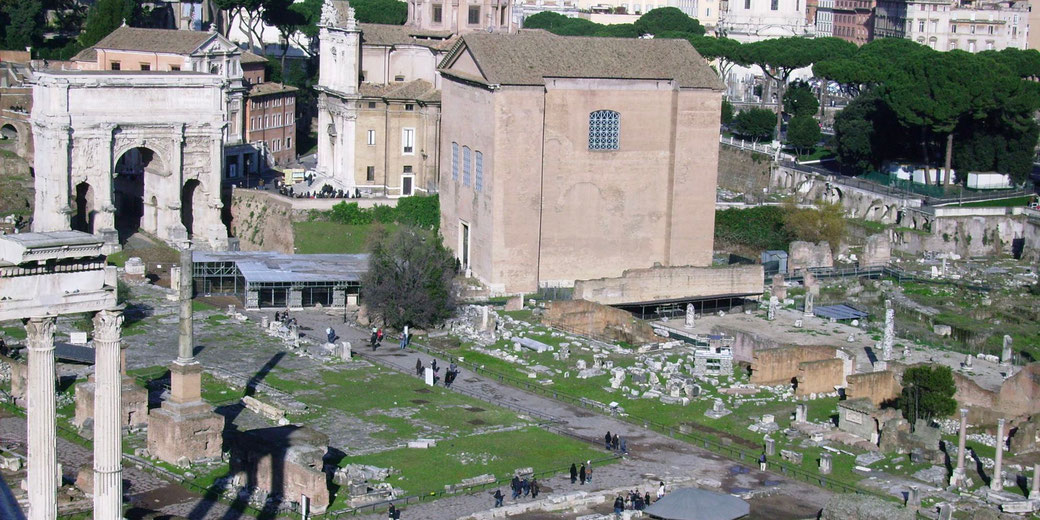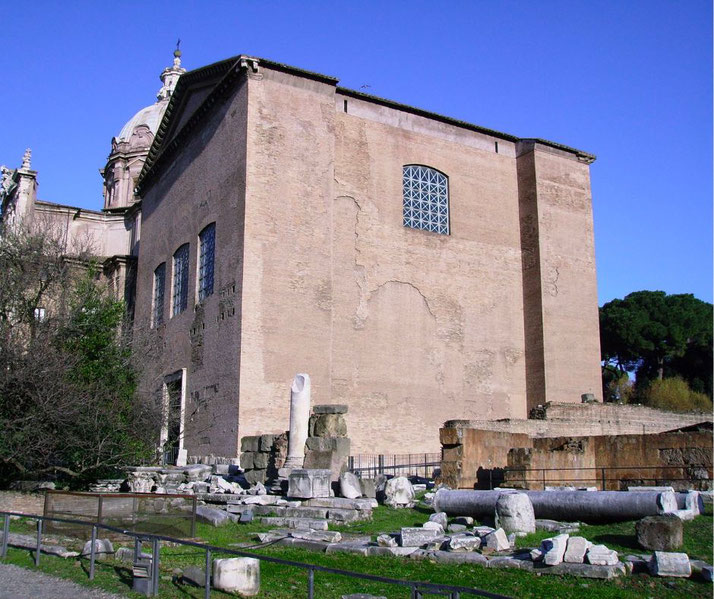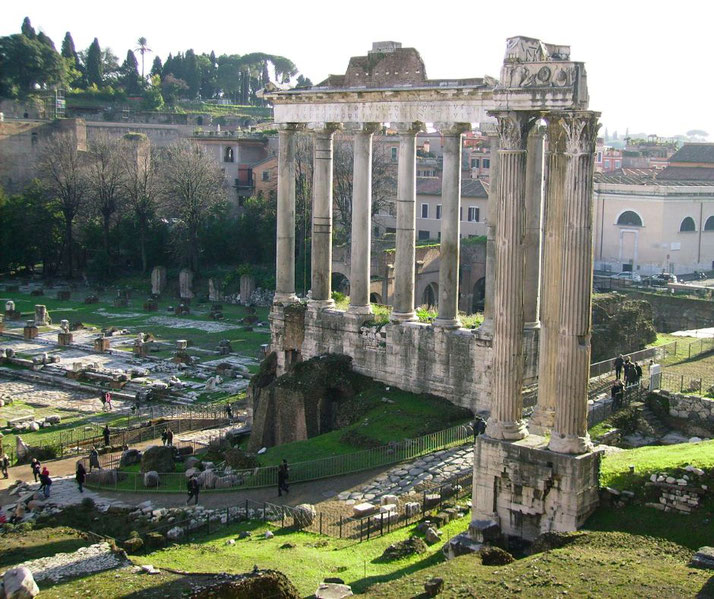The Roman Forum: Where gods, emperors, and commoners converged

The Roman Forum was the heart of Rome: the centre of Roman public life, a busy marketplace, a political arena, and a religious complex, all in one.
Here, emperors were crowned, laws were passed, and speakers like Cicero influenced public opinion.
A brief history of the buildings in the Forum
The Forum first began as a simple marketplace and meeting spot for the growing Roman community after people had drained the marshy valley.
Eventually, as Rome's political and social structures grew more developed, the Forum also changed.
When the Senate House, known as the Curia, was built, it marked an important change that turned the Forum from a marketplace into the political centre of the Roman Republic.
That was where the Roman Senate, whose members were the city's leaders, met to pass laws, debate policy, and make decisions that affected all Romans.
After that, the Rostra, the speaker's platform, became the stage for some of the most famous speeches in history.
From there, speakers like Cicero addressed the public, and they influenced views on military campaigns and legal reforms.
During the rule of Julius Caesar and Augustus, a new era of impressive buildings began.
Caesar started major construction projects that included a new Curia for the growing Senate, and Augustus added large structures like the Temple of Divus Julius.
In doing so, they were displays of power and divine approval rather than practical spaces, meant to impress and inspire.
By this point, as the Roman Empire grew, the Forum became a miniature version of the empire itself. It displayed treasures from distant lands and monuments that celebrated military victories.
Arches such as the Arch of Septimius Severus honoured military successes, and temples to various gods showed Rome's religious variety and tolerance.
Besides monuments, basilicas were large public buildings for business and legal cases.
They added another layer of usefulness to the Forum and served the needs of a growing city.

The various uses of the Forum by the Romans
The Roman Forum was more than just an impressive architecture; it was the beating heart of Roman social and political life.
Imagine walking into the Forum on any given day: merchants who haggled over prices, politicians who delivered passionate speeches, citizens who gathered to discuss the latest news, and priests who performed religious ceremonies.
Politically, the Forum was the centre of power and authority. In this role, it hosted high magistrates and official ceremonies.
The Forum was also the venue for political rallies, public trials, and proclamations of new laws, which made it a lively centre of civic engagement.

Socially, the Forum was a meeting place of Roman society. Beyond politics, it also served everyday economic and social needs.
It was a marketplace where merchants sold goods from across the empire, from foreign spices to expensive textiles.
But it was also a place for social interaction and networking. The rich and powerful would walk through the Forum to see and be seen, while ordinary citizens came to catch up on gossip, find work, or participate in religious ceremonies.
Temples and shrines dotted the landscape. They functioned as community meeting places rather than as places of worship.
The Basilicas, large public buildings, were used for a variety of social functions, which included business transactions and legal proceedings.
The Forum was also a stage for the grand show of Roman triumphs: military parades that celebrated victorious generals and their troops.
These events were social as much as they were political, strengthening the might of Rome and the social hierarchies within its society.
The captives and spoils of war were paraded through the Forum. Meanwhile, these displays underscored Rome's military achievements and its civic rituals.
They often ended with sacrifices to the gods, which mixed politics, religion and public spectacle.
The important religious sites in the Forum
Beyond social and political functions, the Forum also held important religious sites in the Forum.
The Temple of Saturn, one of the Forum's oldest and most significant religious structures, was the main centre of the Saturnalia festival rather than an impressive architecture.
It was a time of feasting and gift-giving that allowed Romans to unwind and temporarily reverse social roles.

The Temple of Vesta was another significant religious site that housed the sacred flame of Vesta, the goddess of the hearth.
The Vestal Virgins were priestesses who were chosen from noble families and were tasked with maintaining this eternal flame.
Their role was highly symbolic rather than religious, as the flame was considered a representation of the state's wellbeing.
The Temple of Castor and Pollux was originally built to commemorate a military victory. It later evolved into a space for religious worship that showed the close relationship between Roman military triumphs and divine favour.

Religious ceremonies in the Forum were often grand public spectacles designed to involve the community and to reinforce shared beliefs.
These ceremonies were political tools used to justify authority and unify the populace rather than acts of devotion.
Emperors and politicians would frequently sponsor religious events or construct new temples to present themselves as pious leaders who were favoured by the gods.
Temples often housed treasuries and functioned as archives that stored important state documents.
Religious leaders held significant political power, and decisions made in the Forum often sought divine approval through omens and auguries.
This blending of the religious and the political made the Forum a space where the boundaries between the earthly and the divine were flexible and showed a worldview where gods and mortals were deeply linked.
The dramatic events which took place in the Forum
The Roman Forum was the stage for many major events that affected the later history of Western civilisation, rather than the history of Rome.
One of the earliest major events was the traditional founding of Rome itself, dated to April 21, 753 BCE, a legendary event later linked to the Forum's original role as a market and gathering spot.
Several centuries later, in 44 BCE, the Forum became the setting for one of history's most famous killings: that of Julius Caesar.
Although Caesar was actually killed in the Theatre of Pompey, his body was brought to the Forum for a public funeral.
The event was a major political event that led to the end of the Roman Republic and the rise of the Roman Empire.
Mark Antony's funeral oration for Caesar is one of the most famous speeches ever given, remembered by Shakespeare and many historians.
Another important event was the Battle of Milvian Bridge in 312 CE, where Constantine the Great won.
After the battle, Constantine attributed his victory to the Christian god, and then made Christianity legal.
This led to a deep change in the religious situation of the Forum, with Christian basilicas eventually replacing many of the ancient Roman temples.
Why is the Forum in ruins today?
As the Western Roman Empire fell in 476 CE, the Forum fell into a state of deterioration and abandonment.
After almost 1,000 years of use, the grand buildings that once showed Rome's strength were reused or taken down.
Temples were turned into Christian churches, and some buildings were even taken down to provide materials for new constructions.
Over time, the Forum became a remnant of its former self, its glory hidden by layers of dirt, debris, and neglect.
During the Middle Ages, the area that had once been the Forum was mostly used for farming and grazing.
It became known as the 'Campo Vaccino', or 'Cow Field', a far cry from its days as the centre of Roman civilisation.
By the time of the Renaissance, scholars had renewed interest in the classical world, but it was not until the 18th and 19th centuries that planned excavations began.
Archaeologists like Carlo Fea and Giuseppe Fiorelli led careful work to unearth the Forum's buried remains, following guidance from ancient texts and early modern drawings.
The 20th century saw an increase in excavation and restoration efforts, especially under the fascist regime of Benito Mussolini, who wanted to glorify Italy's imperial past.
Although the politics at the time were troubling, these efforts did help with major archaeological discoveries, and helped us understand the Forum's layout and history.
In the post-war period, archaeological work continued, helped by advances in technology and methods.
Since then, the Roman Forum has remained one of the most visited archaeological sites in the world. Millions of tourists and scholars explore its remains and imagine its earlier splendour.
What do you need help with?
Download ready-to-use digital learning resources
Copyright © History Skills 2014-2025.
Contact via email
With the exception of links to external sites, some historical sources and extracts from specific publications, all content on this website is copyrighted by History Skills. This content may not be copied, republished or redistributed without written permission from the website creator. Please use the Contact page to obtain relevant permission.





